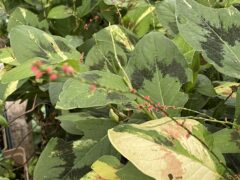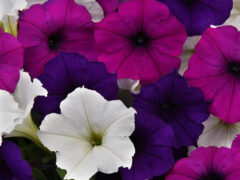
Russian sage
Perovskia atriplicifolia/Perovskia hybrid
Perennial Plant Association 1995 Perennial Plant of the Year! Perovskia atriplicifolia ‘Little Spire’ is a … Continued
 Hummingbirds, bees and butterflies are well-known pollinators, but there are thousands of unsung pollinator heroes, including moths, wasps, flies, and beetles, many mammals, birds, and reptiles, who also take on the job.
Hummingbirds, bees and butterflies are well-known pollinators, but there are thousands of unsung pollinator heroes, including moths, wasps, flies, and beetles, many mammals, birds, and reptiles, who also take on the job.
Pollinators move from plant to plant, fueling up with pollen and nectar from blooming trees, shrubs, perennials, annuals, vegetable plants, and herbs. As they move, the pollinators transport and deposit pollen, fertilizing plants and allowing them to reproduce.
Pollinator plants can be native and non-native, but not all flowering plants are equal when it comes to providing the highest quality protein-rich pollen. Many hybrids don’t even produce pollen at all. The following list includes pollen-rich plants to include in your garden to provide pollinators with food.
Local butterfly expert Lenora Larson has created these informational handouts. You can download them here!
• Butterflies: Flying Flowers in your Garden!
• A Vital Connection: Native Plants and Butterflies
• Long Lips Farm Caterpillar Foodplants
• Butterfly Bartending: Nectar Flowers
• Long Lips Farm: Selected Butterfly Nectar Flowers
• Bee Friendly: Plants for Bees and Other Pollinators
Since 1970 the population of North American birds has dropped nearly 30% — almost three billion birds have vanished from our forests, grasslands, and backyards in less than a human lifetime. It’s a chilling fact that makes it clear that we must act as individuals to help ensure their survival.
Most importantly, ninety-six percent of all terrestrial bird species rear their young on insects so it is also important to grow plants that feed insects to provide a well-rounded habitat in your garden.


Perovskia atriplicifolia/Perovskia hybrid
Perennial Plant Association 1995 Perennial Plant of the Year! Perovskia atriplicifolia ‘Little Spire’ is a … Continued

Persicaria 'Orange Field'
Knotweed is an easy-to-grow perennial with showy spikes of flowers for weeks on end from … Continued

Persicaria virginiana var. filiformis 'Painter's Palette'
Grown primarily for its attractive, variegated foliage, plants form a spreading foliage mound 18-24” tall … Continued

Petunia hybrids
‘Wave’ petunias are the original heat tolerant, low maintenance petunia hybrid. Ground-hugging carpets grow 5-7″ … Continued

Petunia hybrids
An improved selection with low, spreading growth habit and flowers produced all along the trailing … Continued

Petunia hybrids
Crazytunias offer such exciting colors! ‘Crazytunia Star Jubilee’ is a yellow and black bicolor. ‘Crazytunia Mandeville’ is … Continued

Petunia hybrid
Headliner is quickly becoming the growers’ first choice for petunias. This mounded petunia boasts early … Continued

Petunia hybrid
Rays have a naturally compact habit and superior branching, making for endless possibilities in patio … Continued

Phemeranthus {Talinum} calycinus
This native perennial most often occurs in rocky soils and is often found growing in … Continued

Phlox drummondii
Loads of single blooms in clusters atop 6-8″ plants all summer long. Flowers range in … Continued

Phlox paniculata 'Blue Paradise'
Among the bluest, flower color changes markedly according to different light conditions. The flowers are … Continued

Phlox paniculata 'Jeana'
2024 Perennial Plant of the Year Found by and named after Jeana Prewitt of Nashville, … Continued